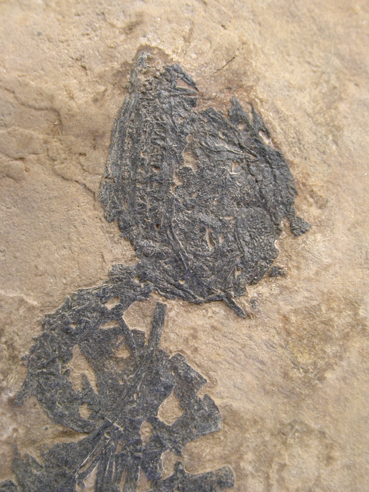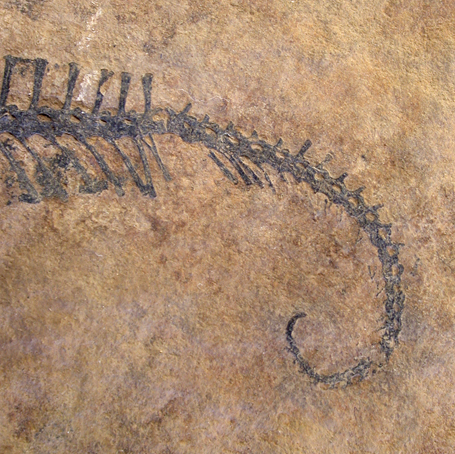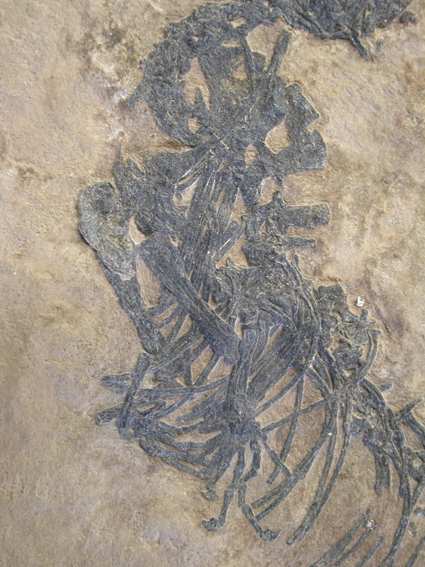

A more in-depth look to Vallesaurus
Nomenclatural issues
Specimen MCSNB 4751 was collected in 1975 by the staff of the Museo di Scienze Naturali of Bergamo. Just after preliminary preparation it was immediately obvious that it represented a new genus and species and was given to Rupert Wild for study with the agreement that the genus was to be named Vallesaurus in honour of the former director of the Museum, the late prof. Valle. The species had to be named cenensis after the small town of Cene (Val Seriana, Bergamo Italy), close to the locality in which the specimen was collected, also famed for having yielded pterosaurs (Wild 1978) and protorosaurs (Renesto 1994c).
Wild never published a description of specimen MCSNB 4751, only quoting the generic name Vallesaurus in a paper (Wild 1991), without giving any clue for identification of the specimen he was referring. Later, Pinna (1993) in a survey on Norian reptiles of Northern Italy, mentioned Vallesaurus cenensis, giving a catalogue number, thus allowing a firm identification of the specimen (Pinna 1993 p.113), and cited Wild as the author of the taxon. Subsequently, the name Vallesaurus cenensis was used in the museum postcards that figured specimen MCSNB 4751 and in other popular publications, so that the name become well known.. Recently, Wild decided to hand on to others the detailed description of the specimen, and he and the Curator f the Paleontological Section of the Museo Civico di Scienze Naturali of Bergamo allowed us to study it. Since after Pinna (1993) the name Vallesaurus cenensis has always been associated to specimen MCSNB 4751 we decided to keep it for the sake of stability, while leaving the authorship to Rupert Wild.
Reptilia
Diapsida Osborn, 1903
Drepanosauridae Olsen & Sues, 1986
Vallesaurus Wild, 1991
Vallesaurus cenensis Wild, 1991
Diagnosis (From Renesto & Binelli 2006)
Small (16 cm total length) drepanosaurid reptile, with digit 4 of the manus as long as the humerus, tarsus with centrale reaching the tibia, modified distal tarsal and metatarsal, hallux clawless and opposable, with one arcuate phalanx. Vallesaurus differs from Megalancosaurus in the proportionally shorter and higher snout, the stouter and larger maxillary and dentary teeth, the shorter cervical vertebrae, the lack of fenestrated hemapophyses in the caudal vertebrae and the lack of fusion between the neural spines of the second and third dorsal vertebrae, as well as in the absence of elongate carpal and tarsal bones and opposable or modified digits in the manus. Vallesaurus differs from Drepanosaurus in the lack of the massive claw of the second digit of the manus and differs from Drepanosaurus, Megalancosaurus and possibly Dolabrosaurus in the lack of a terminal spine at the end of the tail. Vallesaurus differs from Hypuronector in having anteroposteriorly expanded neural spines of the anterior dorsal vertebrae and anterior limbs much shorter than the posterior ones.

The skull of Vallesaurus

Vallesaurus skull and "notarium"
Mode of Life

The prehensile tip of the tail of Vallesaurus
Vallesaurus shares with all other known drepanosaurids a body architecture (Renesto 2000) indicative of a scansorial life-style, in particular, moving on narrow supports such as the twigs of trees. Evidence for arboreal adaptations in drepanosaurids have been detailed elsewhere (Renesto 1994a, b, 2000; Renesto & Paganoni 1995; Renesto & Fraser 2003; Fraser & Renesto 2005; Renesto & Dalla Vecchia 2005)

Vallesaurus anterior dorsal region

Anterior dorsal region and cervical vertebrae
Vallesaurus and other drepanosaurids (with the possible exception of Hypuronector, Colbert & Olsen 2001) possess a notarium-like structure in the anterior dorsal region and highly modified cervical vertebrae, with adaptations that limited lateral mobility and wide hypapophyses. Both structures indicate the presence of powerful muscles and ligaments for the extension of the neck, possibly suggesting a projectile feeding adaptation (Renesto 2000), in which the head was suddenly launched forward to catch prey and the limited lateral mobility prevented undesired torsions of the neck which could have dislocated the cervical vertebrae during the quick extension. In smaller drepanosaurids like Megalancosaurus and Vallesaurus such adaptations may be related to an insectivorous diet; the teeth of Vallesaurus seem well suited to cut or crush the though exoskeleton of insects and other arthropods .

Vallesaurus manus
Unlike in Megalancosaurus, the manus of Vallesaurus has no opposable fingers, however, the shape of the unguals and of the preungual phalanges, along with the length of the fingers, suggest good climbing abilities (Unwin 1987, 1988; Unwin et al. 2000) and the manus of Vallesaurus is very similar to that of the enigmatic diapsid Longisquama insignis also considered an arboreal reptile (Sharov 1971; Unwin et al. 2000). Interestingly, the two taxa also share the presence of a fourth digit which is as long as the humerus (see below).
More on Vallesaurus HERE
Home Research Triassic Reptiles